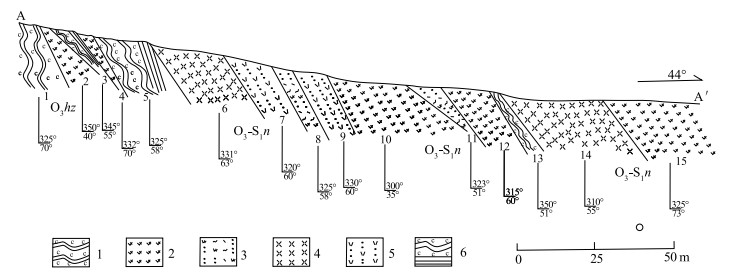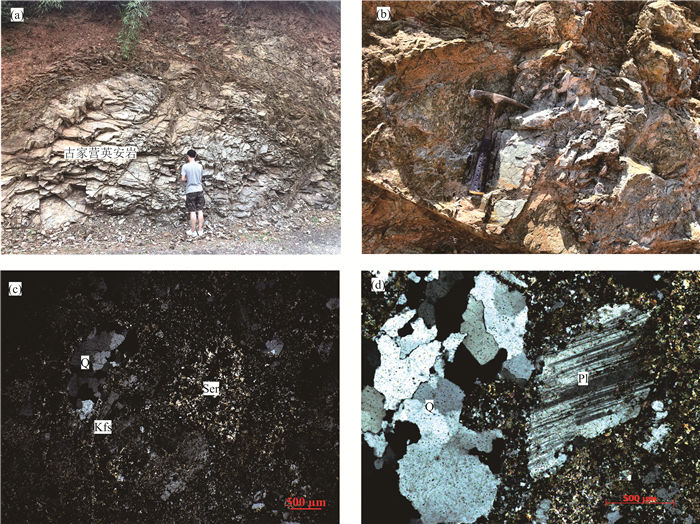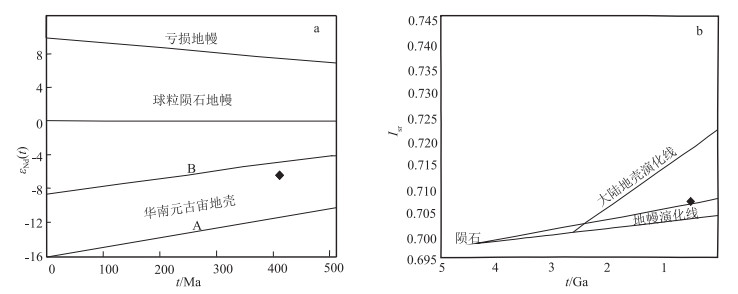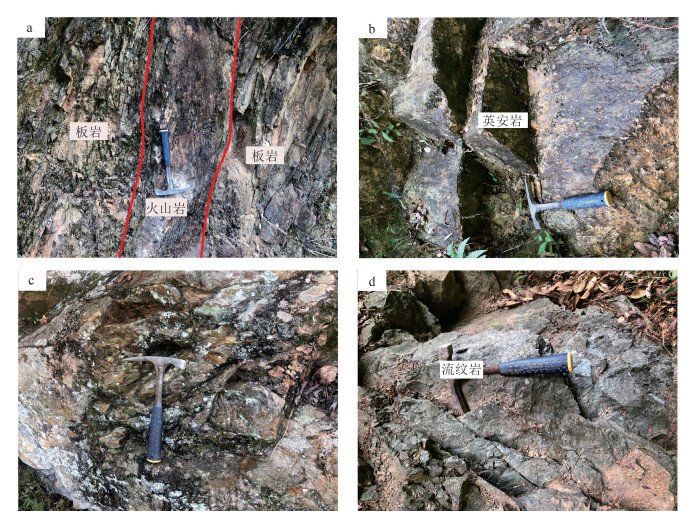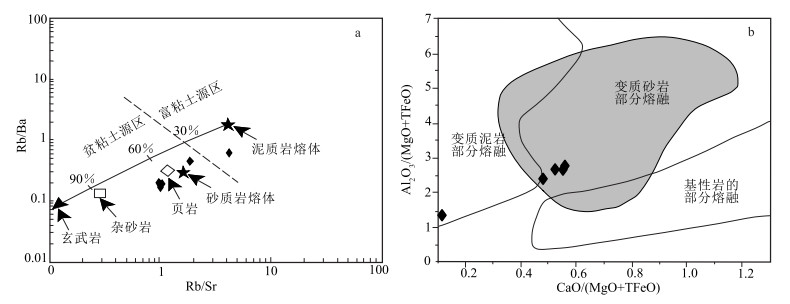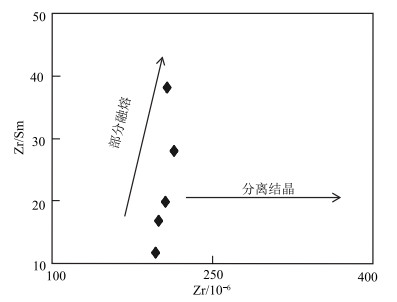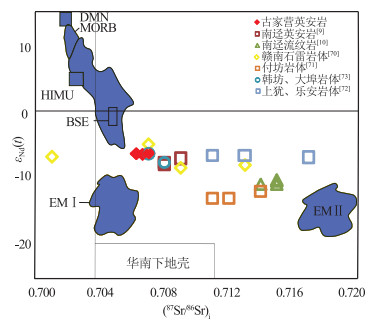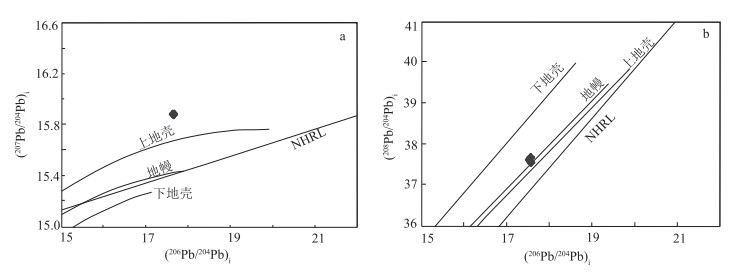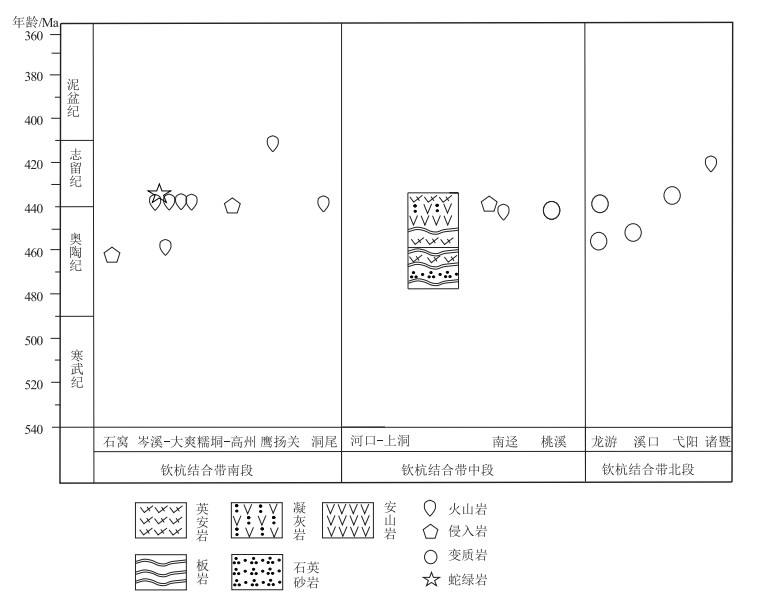Age and genesis of dacite in Gujiaying Basin, southern Jiangxi Province, and its constraints on Early Paleozoic tectonic evolution
-
摘要:
华南板块早古生代的构造属性是长期存在争议的重大地质问题。以赣南古家营盆地英安岩作为研究对象,通过岩石学、野外实测剖面的测量、SHRIMP锆石U-Pb年龄、主微量元素及Sr-Nd-Pb-O同位素分析,对其岩石类型、地层归属、成因及构造环境进行了研究。结果表明:该火山岩具有富硅、富钾、低钠、贫镁的特点,属于高钾钙碱性英安岩;轻重稀土元素分馏明显(La/Yb=5.52~15.08),富集大离子亲石元素Rb、Th、K,亏损高场强元素Ta、Nb及呈现明显的负Eu异常,显示出火山弧的特征;SHRIMP锆石U-Pb年龄分析结果为439.0±4.0 Ma,与南迳英安岩、安山岩年龄一致,均为晚奥陶世末期—早志留世初期岩浆活动的产物,古家营剖面与南迳盆地乔子山标准剖面及中寨标准剖面相似,为一套灰白色英安岩、流纹岩、火山碎屑岩、浅变质岩系组合,在地层上归属于南迳组;负的εNd(t)值(-6.5~-6.3)、较小的(87Sr/86Sr)i值(0.70624~0.70704)、较年轻的TDM2(1685~1703 Ma),以及较高的(206Pb/204Pb)i、(207Pb/204Pb)i、(208Pb/204Pb)i值,指示古家营英安岩为中元古代地壳物质部分熔融形成。古家营英安岩形成于与俯冲有关的岛弧环境,赣南—粤北地区在晚奥陶世—早志留世存在洋陆俯冲作用。
Abstract:The Early Paleozoic tectonic property of the South China Plate has been a major dispute for a long time.The dacite intrusive in the Gujiaying Basin in southern Jiangxi was selected as a case to study its rock type, strata attribution, genesis and structural environment based on petrology, field-measured profile measurement, SHRIMP zircon U-Pb chronology, major trace elements and Sr-Nd-Pb-O isotopic analysis.The analysis results show that the volcanic rock is rich in silicon and potassium, low in sodium, and poor in magnesium, and belongs to the high-K calc-alkaline dacite.Its light and heavy REE show obvious fractionation(La/Yb=5.52~15.08), and it is rich in lithophile elements Rb, Th, K, loss of high field strength elements Ta, Nb, with obvious negative Eu anomalies, showing the characteristics of volcanic arc.SHRIMP zircon U-Pb dating yields 439.0±4.0 Ma, similar to that of Nanying dacite and andesite, suggesting products of magmatic activity from the Late Ordovician to the Early Silurian.The Gujiaying section is similar to the Qiaozishan standard section and the Zhongzhai standard section in the Nanjing Basin.It is a set of gray-white dacite, rhyolite, volcanic clastic rock, and shallow metamorphic rock series, which belongs to the Nanjing Formation.The negative εNd(t) value(-6.5~-6.3), lower (87Sr/86Sr)i value(0.70624~0.70704), younger TDM2(1685~1703 Ma), and higher values(206Pb/204Pb)i, (207Pb/204Pb)i and (208Pb/204Pb)i, indicating that the Gujiaying dacite was formed by partial melting of the Mesoproterozoic crustal material.It is inferred that the Gujiaying dacite was formed in an island-arc environment related to subduction, and ocean-continent subduction existed in southern Jiangxi-northern Guangdong during the Late Ordovician-Early Silurian period.
-
Keywords:
- dacite /
- Caledonian /
- geochemistry /
- zircon U-Pb age /
- isotopes /
- Gujiaying Basin /
- Nanjing Formation /
- Jiangxi Province
-
致谢: 北京离子探针中心杜利林老师在SHRIMP锆石U-Pb年龄测定过程中给予帮助和支持,在此表示感谢。
-
图 1 古家营盆地地质简图(a,据参考文献[19]修改)和大地构造位置(b)
1—第四系; 2—石炭系; 3—泥盆系; 4—上奥陶统-下志留统火山岩; 5—寒武系-上奥陶统变质砂岩; 6—早燕山中期花岗岩; 7—印支晚期花岗岩; 8—印支早期花岗岩; 9—加里东期花岗岩; 10—地质界线; 11—角度不整合接触; 12—断层; 13—采样位置;14—剖面位置
Figure 1. Simplified geological map(a)and geotectonic location(b)of Gujiaying Basin
图 6 古家营英安岩稀土元素球粒陨石标准化(a)与微量元素原始地幔标准化图(b)(标准化值据参考文献[48])
Figure 6. Chondrite-normalized REE patterns(a)and primitive mantle-normalized trace element spider diagrams(b)of dacite in Gujiaying Basin
图 8 南迳盆地晚奥陶世晚期—早志留世南迳组实测剖面B-B'[37]
1—第四系沉积物;2—石英砂岩;3—砂砾岩;4—英安质角砾凝灰岩;5—英安质晶屑熔结凝灰岩;6—安山岩;7—英安岩;8—板岩;O3hz—黄竹洞组;O3-S1n—南迳组;D2y—云山组
Figure 8. Geological section B-B′ of the Nanjing Formation in Nanjing Basin
图 9 南迳盆地晚奥陶世晚期—早志留世南迳组实测剖面C-C'[37]
1—第四系沉积物;2—安山质角砾凝灰岩;3—安山质晶屑熔结凝灰岩;4—安山岩;5—英安岩;6—板岩;7—千枚岩;8—变质砂岩;O3hz—黄竹洞组;O3-S1n—南迳组
Figure 9. Geological section C-C′ of the Nanjing Formation in Nanjing Basin
图 14 古家营英安岩(206Pb/204Pb)i-(207Pb/204Pb)i(a)和(206Pb/204Pb)i-(208Pb/204Pb)i(b)图解(底图据参考文献[76])
Figure 14. The (206Pb/204Pb)i-(207Pb/204Pb)i (a)and (206Pb/204Pb)i-(208Pb/204Pb)i (b)diagrams of Gujiaying dacite
表 1 古家营盆地英安岩SHRIMP锆石U-Th-Pb分析结果
Table 1 SHRIMP zircon U-Th-Pb analysis of Gujiaying dacite
点号 206Pbc
/%U
/10-6Th
/10-6232Th/
238U206Pb*
/10-6206Pb/ 238U
年龄/Ma207Pb*/
235U±% 206Pb*/
238U±% 误差 1.1 0.35 290 134 0.48 17.8 443.8±7.4 0.530 3.9 0.0713 1.7 0.445 2.1 0.45 571 308 0.56 34.3 434.0±7.0 0.512 2.9 0.0696 1.7 0.571 3.1 1.04 274 133 0.50 16.9 443.3±7.5 0.498 5.6 0.0712 1.7 0.313 4.1 0.60 319 170 0.55 19.4 437.4±7.3 0.512 4.4 0.0702 1.7 0.392 5.1 0.31 610 390 0.66 36.6 433.5±6.9 0.510 2.6 0.0696 1.7 0.636 6.1 0.60 292 117 0.41 17.6 433.2±7.9 0.491 4.7 0.0695 1.9 0.396 7.1 0.59 288 143 0.51 17.6 441.0±7.4 0.491 4.3 0.0708 1.7 0.405 8.1 0.30 562 360 0.66 33.8 435.1±7.0 0.528 3.0 0.0698 1.7 0.559 9.1 0.34 462 261 0.58 28.4 443.3±7.2 0.517 2.4 0.0712 1.7 0.704 10.1 0.23 709 376 0.55 43.3 441.4±7.6 0.532 2.4 0.0709 1.8 0.756 11.1 0.32 362 173 0.49 22.4 446.8±7.4 0.543 3.7 0.0718 1.7 0.463 12.1 0.30 430 178 0.43 26.5 444.5±7.3 0.528 3.3 0.0714 1.7 0.520 13.1 0.16 458 260 0.59 27.6 436.7±7.2 0.527 2.8 0.0701 1.7 0.601 注:206Pbc和206Pb*分别表示普通铅和放射性成因铅;普通铅根据实测204Pb进行校正 表 2 古家营盆地英安岩主量、微量和稀土元素分析结果
Table 2 Analysis results of major, trace elements and rare earth elements of Gujiaying dacite
样品号 GJY001 GJY002 GJY003 GJY004 GJY005 样品号 GJY001 GJY002 GJY003 GJY004 GJY005 SiO2 71.84 67.79 70.38 68.7 70.51 ∑REE 300 355 259 231 144 TiO2 0.46 0.4 0.45 0.51 0.45 LREE/HREE 7.00 7.82 6.30 8.40 5.34 Al2O3 13.61 13.82 14.28 13.75 14.29 (La/Yb) N 10.19 15.08 9.36 9.29 5.52 TFe2O3 4.3 4.35 4.29 4.59 4.44 δEu 0.57 0.56 0.59 0.53 0.69 MnO 0.08 0.09 0.08 0.09 0.09 δCe 0.56 0.35 0.52 0.92 0.79 MgO 0.84 5.91 0.89 1.17 0.94 Sr 165 39.5 154 111 159 CaO 2.5 0.1 2.56 2.32 2.45 Rb 169 164 152 205 153 Na2O 2.06 1.00 2.13 1.99 2.03 Th 19.2 19.2 17.6 18.2 17.0 K2O 3.41 3.00 3.75 3.53 3.87 U 3.85 4.40 4.04 3.12 3.88 P2O5 0.13 0.07 0.11 0.14 0.13 Nb 11.2 10.2 11.1 10.9 11.0 烧失量 0.97 3.50 1.03 3.34 0.96 Ta 1.09 1.03 1.06 0.93 1.05 总计 100 100 100 100 100 Ba 879 265 889 453 766 ALK 5.47 4.00 5.88 5.52 5.90 Ga 19.7 17.3 19.9 18.2 19.3 CaO/Na2O 1.21 0.10 1.20 1.17 1.21 Hf 6.17 5.91 6.08 6.13 6.36 A/CNK 1.17 2.72 1.17 1.21 1.19 Zr 199 196 206 214 207 K2O/Na2O 1.66 3.00 1.76 1.77 1.91 Y 49.9 45.7 48.3 30.9 30.4 Al2O3/TiO2 29.59 34.55 31.73 26.96 31.76 Cr 14.6 20.4 22.8 52.0 14.3 刚玉(c) 2.23 9.23 2.27 2.82 2.57 Co 6.63 6.58 6.25 9.08 6.85 Tzr/℃ 857 874 858 863 858 Ni 7.52 23.7 12.1 38.1 8.07 La 79.1 104 67.2 49.4 29.8 Sc 13.5 11.0 13.8 14.9 12.9 Ce 93.0 80.3 74.4 97.2 51.8 Zr+Nb+Ce+Y 353.49 332.66 339.52 352.78 300.49 Pr 16.25 23.36 14.34 10.69 6.79 10000Ga/Al 2.74 2.36 2.63 2.49 2.55 Sm 11.62 16.14 10.31 7.58 5.45 Th/Ta 17.63 18.55 16.59 19.65 16.16 Eu 2.10 2.75 1.98 1.27 1.26 La/Nb 7.04 10.18 6.03 4.55 2.71 Gd 10.84 13.23 10.17 6.87 5.74 Ba/Nb 78.21 26.01 79.89 41.75 69.77 Tb 2.02 2.35 1.91 1.26 1.03 Ba/La 11.12 2.56 13.24 9.18 25.72 Dy 10.12 11.26 9.62 6.49 6.13 Th/Nb 1.71 1.88 1.58 1.68 1.55 Ho 2.04 2.05 1.98 1.38 1.32 Th/La 0.24 0.18 0.26 0.37 0.57 Er 5.76 5.36 5.47 3.87 3.79 Nb/La 0.14 0.10 0.17 0.22 0.37 Tm 0.81 0.72 0.75 0.55 0.54 Nb/Ta 10.32 9.86 10.52 11.69 10.45 Yb 5.17 4.58 4.79 3.54 3.60 Rb/Sr 1.02 4.16 0.99 1.84 0.97 Lu 0.74 0.71 0.72 0.56 0.53 注:主量元素含量单位为%,微量和稀土元素含量单位为10-6 表 3 古家营盆地英安岩Sr-Nd-Pb-O同位素分析结果
Table 3 Sr-Nd-Pb-O isotope analysis of Gujiaying dacite
样品号 GJY001 GJY003 GJY005 Rb/10-6 207.8 154.7 149.8 Sr/10-6 113.2 155.9 152.7 87Rb/ 86Sr 5.409 2.916 2.898 87Sr/ 86Sr 0.740062 0.724871 0.725163 1σ ±7 ±10 ±9 (87Sr/ 86Sr) i 0.70624 0.70664 0.70704 Sm/10-6 7.726 10.64 5.637 Nd/10-6 41.39 56.03 26.12 147Sm/ 144Nd 0.1121 0.1147 0.0948 143Nd/ 144Nd 0.512069 0.512071 0.512025 1σ ±8 ±9 ±10 (143Nd/ 144Nd) i 0.511747 0.511741 0.511752 εNd(t) -6.4 -6.5 -6.3 fSm/Nd -0.43 -0.42 -0.52 TDM 1/Ma 1621 1661 1442 TDM 2/Ma 1694 1703 1685 206Pb/ 204Pb 17.853 17.861 17.847 207Pb/ 204Pb 15.931 15.933 15.925 208Pb/ 204Pb 38.513 38.517 38.524 (206Pb/ 204Pb) i 17.187 17.151 17.181 (207Pb/ 204Pb) i 15.894 15.894 15.888 (208Pb/ 204Pb) i 37.443 37.521 37.584 δ 18OVSMOW/‰ 9.17 8.12 8.64 -
Wang J, Li Z X. History of Neoproterozoic Rift Basins in South China: Implications for Rodinia Break-Up[J]. Precambrian Research, 2003, 122(1/4): 141-158. http://www.sciencedirect.com/science/article/pii/S0301926802002097
周新民. 对华南花岗岩研究的若干思考[J]. 高校地质学报, 2003, 9(4): 556-565. doi: 10.3969/j.issn.1006-7493.2003.04.009 舒良树. 华南前泥盆世构造演化: 从华夏地块到加里东期造山带[J]. 高校地质学报, 2006, 12(4): 418-431. doi: 10.3969/j.issn.1006-7493.2006.04.002 舒良树. 华南构造演化的基本特征[J]. 地质通报, 2012, 31(7): 1035-1053. doi: 10.3969/j.issn.1671-2552.2012.07.003 张芳荣, 舒良树, 王德滋, 等. 华南东段加里东期花岗岩类形成构造背景探讨[J]. 地学前缘, 2009, 16(1): 248-260. doi: 10.3321/j.issn:1005-2321.2009.01.027 张国伟, 郭安林, 王岳军, 等. 中国华南大陆构造与问题[J]. 地球科学, 2013, 43(10): 1553-1582. https://www.cnki.com.cn/Article/CJFDTOTAL-JDXK201310003.htm 李三忠, 李玺瑶, 赵淑娟, 等. 全球早古生代造山带(Ⅲ): 华南陆内造山[J]. 吉林大学学报(地球科学版), 2016, 4: 1005-1025. https://www.cnki.com.cn/Article/CJFDTOTAL-CCDZ201604003.htm 易立文, 马昌前, 王连训, 等. 华南晚奥陶世次火山岩的发现: 早古生代与俯冲有关的英安岩?[J]. 地球科学(中国地质大学学报), 2014, 6: 637-653. https://www.cnki.com.cn/Article/CJFDTOTAL-DQKX201406001.htm 劳玉军. 赣南南迳盆地加里东期英安岩地质、地球化学特征及地质意义[D]. 东华理工大学硕士学位论文, 2017. 马树松. 赣南南迳盆地流纹岩年代学、地球化学特征及其地质意义[D]. 东华理工大学硕士学位论文, 2020. 覃小锋, 王宗起, 宫江华, 等. 云开地块北缘加里东期中-基性火山岩的厘定: 钦-杭结合带南西段早古生代古洋盆存在的证据[J]. 岩石学报, 2017, 33(3): 791-809. https://www.cnki.com.cn/Article/CJFDTOTAL-YSXB201703010.htm 覃小锋, 王宗起, 王涛, 等. 桂东鹰扬关群火山岩时代和构造环境的重新厘定: 对钦杭结合带西南段构造格局的制约[J]. 地球学报, 2015, 36(3): 283-292. https://www.cnki.com.cn/Article/CJFDTOTAL-DQXB201503003.htm 彭松柏, 刘松峰, 林木森, 等. 华夏早古生代俯冲作用(Ⅱ): 大爽高镁-镁质安山岩新证据[J]. 地球科学, 2016, 41(6): 931-947. https://www.cnki.com.cn/Article/CJFDTOTAL-DQKX201606003.htm 刘松峰. 华南云开隆起西北缘早古生代构造混杂岩带成因及构造演化[D]. 中国地质大学博士学位论文, 2018. 彭松柏, 刘松峰, 林木森, 等. 华夏早古生代俯冲作用(Ⅰ): 来自糯垌蛇绿岩的新证据[J]. 地球科学, 2016, 41(5): 765-778. https://www.cnki.com.cn/Article/CJFDTOTAL-DQKX201605004.htm 覃小锋, 王宗起, 胡贵昂, 等. 两广交界地区壶垌片麻状复式岩体的年代学和地球化学: 对云开地块北缘早古生代构造-岩浆作用的启示[J]. 岩石学报, 2013, 9: 3115-3130. https://www.cnki.com.cn/Article/CJFDTOTAL-YSXB201309013.htm 王存智, 姜杨, 赵希林, 等. 陈蔡岩群下河图斜长角闪岩年代学、地球化学特征及其构造意义[J]. 岩石矿物学杂志, 2016, (3): 425-442. doi: 10.3969/j.issn.1000-6524.2016.03.004 杨瞳, 虞鹏鹏. 钦杭结合带加里东期造山运动构造属性探究[J]. 中山大学研究生学刊, 2015, 36(3): 1-7. https://www.cnki.com.cn/Article/CJFDTOTAL-KWXB2015S1697.htm 马树松, 刘帅, 黄美化, 等. 赣南苗云岩体U-Pb年代学、地球化学特征及其成因[J]. 科学技术与工程, 2019, 19(26): 55-67. doi: 10.3969/j.issn.1671-1815.2019.26.008 杜云, 郭爱民, 卢友月, 等. 湘西南苗儿山岩体加里东期花岗岩成因: 来自岩石学、地球化学和锆石U-Pb年代学证据[J/OL]. 中国地质(网络首发), 2019, 1-28. http://kns.cnki.net/kcms/detail/11.1167.P.20191223.1713.006.html. 于津海, 周新民, O'Reilly Y S等. 南岭东段基底麻粒岩相变质岩的形成时代和原岩性质: 锆石的U-Pb-Hf同位素研究[J]. 科学通报, 2005, 50: 1758-1767. doi: 10.3321/j.issn:0023-074X.2005.16.015 陈相艳, 仝来喜, 张传林, 等. 浙江龙游石榴石角闪岩(退变榴辉岩): 华夏加里东期碰撞造山事件的新证据[J]. 科学通报, 2015, 60(13): 1207-1217. https://www.cnki.com.cn/Article/CJFDTOTAL-KXTB201513008.htm Zhang C L, Santosh M, Zhu Q B, et al. The gondwana connection of south china: evidence from monazite and zircon geochronology in the cathaysia block[J]. Gondwana Research, 2014, 28(3): 1137-1151. http://www.sciencedirect.com/science/article/pii/S1342937X14002822
汪建国, 余盛强, 胡艳华, 等. 江山-绍兴结合带榴闪岩的发现及岩石学、年代学特征[J]. 中国地质, 2014, 41(4): 1356-1363. doi: 10.3969/j.issn.1000-3657.2014.04.025 于津海, 楼法生, 王丽娟, 等. 赣东北弋阳早古生代麻粒岩的发现及其地质意义[J]. 科学通报, 2014, (35): 3508-3516. https://www.cnki.com.cn/Article/CJFDTOTAL-KXTB201435010.htm 姜杨, 陈志洪, 谭桂丽, 等. 钦杭结合带加里东期榴闪岩超高压变质作用研究[J]. 资源调查与环境, 2015, 36(2): 79-88. doi: 10.3969/j.issn.1671-4814.2015.02.001 Zhang S B, Zheng Y F. Formation and evolution of Precambrian continental lithosphere in South China. Gondwana Research[J]. 2013, 23: 1241-260. doi: 10.1016/j.gr.2012.09.005
高彭. 华南陆块南岭地区中生代花岗岩地球化学研究[D]. 中国科学技术大学博士学位论文, 2016. 吴荣新, 郑永飞, 吴元宝. 皖南石耳山新元古代花岗岩锆石U-Pb定年以及元素和氧同位素地球化学研究[J]. 高校地质学报, 2005, 11(3): 364-382. doi: 10.3969/j.issn.1006-7493.2005.03.008 杜云, 罗小亚, 黄革非. 湘西南苗儿山岩体北段新元古代晋宁期花岗岩岩石学、地球化学特征及其形成构造背景[J]. 地质科技情报, 2017, 36(6): 136-147. 高万里, 王宗秀, 李春麟, 等. 浙东南印支期花岗岩的锆石U-Pb年代学、地球化学及构造意义[J]. 地质学报, 2014, 6: 1055-1067. https://www.cnki.com.cn/Article/CJFDTOTAL-DZXE201406008.htm 杜远生, 徐亚军. 华南加里东运动初探[J]. 地质科技情报, 2012, (5): 47-53. 袁正新, 钟国芳, 谢宕豹, 等. 华南地区加里东造山运动时空分布的新认识[J]. 华南地质与矿产, 1997, 4: 19-25. https://www.cnki.com.cn/Article/CJFDTOTAL-HNKC199704002.htm Wang Y J, Zhang A M, Fan W M, et al. Kwangsian crustal anatexis within the eastern South China Block: geochemical, zircon U-Pb geochronological and Hf isotopic fingerprints from the gneissoid granitesof Wugong and Wuyi-Yunkai Domains[J]. Lithos, 2011, 127: 239-260. doi: 10.1016/j.lithos.2011.07.027
巫建华, 徐勋胜, 刘帅. 赣南-粤北地区晚白垩世早期长英质火山岩SHIRMP锆石U-Pb年龄及其地质意义[J]. 地质通报, 2012, 31(8): 1298-1305. http://dzhtb.cgs.cn/gbc/ch/reader/view_abstract.aspx?file_no=20120809&flag=1 伍静, 王广强, 梁华英, 等. 粤北大宝山矿区加里东期火山岩的厘定及其地质意义[J]. 岩石学报, 2014, 4: 1145-1154. https://www.cnki.com.cn/Article/CJFDTOTAL-YSXB201404019.htm 丁辉. 江西南部南迳盆地安山岩年代学、地球化学特征及岩石成因[D]. 东华理工大学硕士学位论文, 2016. 宋彪, 张玉海, 万渝生, 等. 锆石SHRIMP样品靶制作、年龄测定及有关现象讨论[J]. 地质论评, 2002, 48(增刊1): 26-30. https://www.cnki.com.cn/Article/CJFDTOTAL-DZLP2002S1006.htm Ludwig K R. User's manual for Isoplot/Ex (Version 2.05): A geochronological toolkit for Microsoft Excel[M]. Spec. Pub, Berkeley Geochro-nology Center Special publication, 2001: 1-55.
高剑峰, 陆建军, 赖鸣远, 等. 岩石样品中微量元素的高分辨率等离子质谱分析[J]. 南京大学学报(自然科学), 2003, 39(6): 844-850. https://www.cnki.com.cn/Article/CJFDTOTAL-NJDZ200306013.htm Williams I S, Claesson S. Isotopic evidence for the Precambrianprovenance and Caledonian Metamor phism of high grade paragneisses from the Seve Nappes, Scandinavian Caledonides Ⅲ on micro-probe zircon U-Th-Pb[J]. Contributions to Mineralogy & Petrology, 1987, 97: 205-217. doi: 10.1007/BF00371240
Rubatto D. Zircon trace element geochemistry: Partitioning with gar-net and link between U-Pb ages andmetamorphism[J]. Chemical Geology, 2002, 184: 123-138. doi: 10.1016/S0009-2541(01)00355-2
吴元保, 郑永飞. 锆石成因矿物学研究及其对U-Pb年龄解释的制约[J]. 科学通报, 2004, 49(16): 1589-1604. doi: 10.3321/j.issn:0023-074X.2004.16.002 章森桂, 张允白, 严惠君. "国际地层表"简介[J]. 地层学杂志, 2008, 33(1): 1-10. doi: 10.3969/j.issn.0253-4959.2008.01.001 Le Bas M J, Le Maitre R W, Streckeisen A, et al. A chemical classi-fication of volcanic rocks based on the total alkali-silicadiagram[J]. Journal of Petrology, 1986, (3): 745-750. http://citeseerx.ist.psu.edu/viewdoc/download;jsessionid=085B09F566679259DD391A8CAB547BF9?doi=10.1.1.923.434&rep=rep1&type=pdf
Richwood P C. Boundary lines within petrologic diagrams which use oxides of major and minorelements[J] Lithos, 1989, 22(4): 247-263. doi: 10.1016/0024-4937(89)90028-5
Peccerillo A, Taylor R. Geoehemistry of Eoceno calc-alkaline vol-canic rocks from the Kastamawarea, northern Turkey[J]. Mineralogy and Petrology, 1976, 58: 63-81. doi: 10.1007/BF00384745
Sun S S, Mc Donoungh W F. Chemical and isotopic systematics ofoceanic basalt: Implication for mantle composition and processes[J]. Magmatism in the Ocean, 1989, 42: 313-345. http://citeseerx.ist.psu.edu/viewdoc/download?doi=10.1.1.924.518&rep=rep1&type=pdf
毛建仁, 厉子龙, 叶海敏. 华南中生代构造-岩浆活动研究: 现状与前景[J]. 中国科学: 地球科学, 2014, 44(12): 2593-2617. https://www.cnki.com.cn/Article/CJFDTOTAL-JDXK201412001.htm 江西省地质矿产局. 江西省区域地质志[M]. 北京: 地质出版社, 1984. 江西省地质矿产厅. 江西省岩石地层[M]. 武汉: 中国地质大学出版社, 1997: 275-282. 巫建华, 周维勋, 章邦桐. 江西及广东北部中生代晚期地层层序和时代——兼论《江西省岩石地层》中存在的问题[J]. 地质论评, 2002, 48(1): 44-53. doi: 10.3321/j.issn:0371-5736.2002.01.008 陈武钦, 王漂元, 林建. 华粤北始兴县城南志留纪火山岩的基本特征[J]. 中国西部科技, 2006, 16: 29-30. https://www.cnki.com.cn/Article/CJFDTOTAL-XBKJ200616021.htm 吴继光. 南岭贵东岩体北部英安斑岩锆石LA-ICPMS U-Pb年龄及其地质意义[J]. 铀矿地质, 2013, 5: 268-273, 262. doi: 10.3969/j.issn.1000-0658.2013.05.003 Sylvester P J. Post-collisional strongly peraluminousgranites[J]. Lithos, 1998, 45(1/4): 29-44. http://www.researchgate.net/profile/Paul_Sylvester/publication/223458063_Post-collisional_strongly_peraluminous_granites._Lithos/links/00b7d51c4ff86b1f39000000.pdf
邓晋福, 苏尚国, 赵海玲, 等. 华北地区燕山期岩石圈减薄的深部过程[J]. 地学前缘, 2003, 3: 41-50. doi: 10.3321/j.issn:1005-2321.2003.03.003 Whalen J B, Crurrie K L, Chappell B W. A-type granite: Geochemical characteristics, discrimination and petrogenesis[J]. Contribution to Mineralogy and Petrology, 1987, 95(4): 407-419. doi: 10.1007/BF00402202
Chappell B W, White A J R. Two contrasting granitetypes[J]. Pacific Geology, 1974, 8: 173-174.
王德滋, 刘昌实, 沈渭洲, 等. 桐庐I型和相山S型两类碎斑熔岩对比[J]. 岩石学报, 1993, 9(1): 44-54. doi: 10.3321/j.issn:1000-0569.1993.01.005 Altherr R, Holl A, Hegner E, et al. High-potassium, calc-alkaline I-type plutonism in the European Variscides: northern Vosges (France) and northern Schwarzwald (Germany)[J]. Lithos, 2000, 50(1): 51-73. http://www.sciencedirect.com/science/article/pii/S0024493799000523
Taylor S R, McLennan S M. The Continental Crust: Its Composition and Evolution[M]. Oxford: Blackwell, 1985: 1-312.
Green T H. Significance of Nb/Ta as an indicator of geochemical processes in the crust-mantlesystem[J]. chemical Geology, 1995, 120: 347-359. doi: 10.1016/0009-2541(94)00145-X
Rudnick R L, Gao S. Composition of the continental crust[C]//Holland H D, Turekian K K. Treatise on Geochemistry. Oxford: Elsevire-Pergamon, 2003: 1-64.
崔泽宏, 唐跃. 塔河地区海西晚期火山岩地球化学特征及地质意义[J]. 中国地质, 2010, 2: 334-346. doi: 10.3969/j.issn.1000-3657.2010.02.007 张芳荣. 江西中-南部加里东期花岗岩地质地球化学特征及其成因[D]. 南京大学博士学位论文, 2011. 陈玉良, 康文彬, 梅华平, 等. 甘肃北山北部红石山地区泥盆系雀儿山群火山岩地球化学特征及构造环境分析[J]. 西北地质, 2015, 4: 50-60. doi: 10.3969/j.issn.1009-6248.2015.04.006 Wedepohl K H. The composition of the continentalcrust[J]. Geochimica et cosmochimica Acta, 1995, 59(7): 1217-1232. doi: 10.1016/0016-7037(95)00038-2
Taylor S R, Mclenna S M. The geochemical evolution of the continental crust[J]. Reviews of Geophysics, 1995, 33(2): 241-265. doi: 10.1029/95RG00262
邵济安, 牟保磊, 朱慧忠, 等. 大兴安岭中南段中生代成矿物质的深部来源与背景[J]. 岩石学报, 2010, 26(3): 649-656. https://www.cnki.com.cn/Article/CJFDTOTAL-YSXB201003001.htm 李光来, 华仁民, 胡东泉, 等. 赣南地区石雷石英闪长岩的成因: 岩石化学、副矿物微量元素、锆石U-Pb年代学与Sr-Nd-Hf同位素制约[J]. 岩石学报, 2010, 3: 903-918. https://www.cnki.com.cn/Article/CJFDTOTAL-YSXB201003021.htm 张芳荣, 舒良树, 王德滋, 等. 江西付坊花岗岩体的年代学、地球化学特征及其成因研究[J]. 高校地质学报, 2010, 2: 161-176. doi: 10.3969/j.issn.1006-7493.2010.02.004 张芳荣, 沈渭洲, 舒良树, 等. 江西省早古生代晚期花岗岩的地球化学特征及其地质意义[J]. 岩石学报, 2010, 26(12): 3456-3468. https://www.cnki.com.cn/Article/CJFDTOTAL-YSXB201012003.htm 王丽丽. 华南赣州地区早古生代晚期-中生代花岗岩类地球化学与岩石成因[D]. 中国地质大学(北京)博士学位论文, 2015. 李伍平, 路凤香, 孙善平, 等. 北京西山东岭台组(J3d)火山岩的成因及其构造环境探讨[J]. 岩石学报, 2000, 16(3): 345-352. https://www.cnki.com.cn/Article/CJFDTOTAL-YSXB200003004.htm 周云, 梁新权, 梁细荣, 等. 海南白垩纪六罗村组火山岩的年代学、地球化学特征及其大地构造意义[J]. 大地构造与成矿学, 2015, 5: 903-918. https://www.cnki.com.cn/Article/CJFDTOTAL-DGYK201505013.htm 李龙, 郑永飞, 周建波. 中国大陆地壳铅同位素演化的动力学模型[J]. 岩石学报, 2001, 1: 61-68. https://www.cnki.com.cn/Article/CJFDTOTAL-YSXB200101007.htm 章邦桐, 陈培荣, 凌洪飞, 等. 赣南中侏罗世玄武岩的Pb-Nd-Sr同位素地球化学研究: 中生代地幔源区特征及构造意义[J]. 高校地质学报, 2004, 10(2): 145-156. doi: 10.3969/j.issn.1006-7493.2004.02.001 许德如, 陈广浩, 夏斌, 等. 湘东地区板杉铺加里东期埃达克质花岗闪长岩的成因及地质意义[J]. 高校地质学报, 2006, 4: 507-521. doi: 10.3969/j.issn.1006-7493.2006.04.012 张浅深, 俞受鋆, 黄建辉, 等. 江南部前泥盆系的初步认识[J]. 地质学报, 1964, 4: 388-404, 488. 欧阳京, 汪双双, 于漫, 等. 岛弧环境中不同成因的火成岩组合及其地质意义[J]. 甘肃地质, 2010, 19(2): 18-26. https://www.cnki.com.cn/Article/CJFDTOTAL-GSDZ201002004.htm 祁晓鹏, 杨杰, 范显刚, 等. 东昆仑造山带东段牦牛山组英安岩年代学和地球化学研究[J]. 矿物岩石地球化学通报, 2018, 37(3): 482-494. https://www.cnki.com.cn/Article/CJFDTOTAL-KYDH201803010.htm Momme P, Tegner C C, Brooks C K R, et al. Two melting regimes during Paleogene flood basalt generation in East Greenland: combined REE and PGE modeling[J]. Contributions to Mineralogy and Petrology, 2006, 15(1): 88-100. http://www.researchgate.net/profile/Christian_Tegner/publication/225502609_Two_melting_regimes_during_Paleogene_flood_basalt_generation_in_East_Greenland_Combined_REE_and_PGE_modelling/links/573af04c08aea45ee840249f.pdf
Sigmarssona O, Steinthbrssonb S. Origin of Icelandic hasalts: A review of their petrology and geochemistry[J]. Journal of Geodynamics, 2007, 43(1): 87-100. doi: 10.1016/j.jog.2006.09.016
汤鸿伟, 康孔跃, 杨伟, 等. 西昆仑胜利桥一带晚三叠世侵入岩年代学、岩石地球化学特征及其地质意义[J]. 科学技术与工程, 2017, 17(15): 1-11. doi: 10.3969/j.issn.1671-1815.2017.15.001 Gorton M P, Schandl E S. From continents to island arcs: A geochemical index of tectonic setting for arc-related and within-plate felsic to intemediate volcanic rocks[J]. Canada Mineral, 2000, 38: 1065-1073. doi: 10.2113/gscanmin.38.5.1065
Harris, N B W. Geochemical characteristics of collision-zone magmatism[J]. Collision Tectonics, 1986, 19: 67-81. http://www.researchgate.net/profile/Julian_Pearce2/publication/42796892_Geochemical_characteristics_of_collision_zone_magmatism/links/564dcbb708ae1ef9296ad0ee.pdf
曾勇, 杨明桂. 赣中碰撞混杂岩带[J]. 地质通报, 1999, (1): 17-22. doi: 10.3969/j.issn.1671-2552.1999.01.003 胡受奚, 叶瑛. 对"华夏古陆"、"华夏地块"及"扬子-华夏古陆统一体"等观点的质疑[J]. 高校地质学报, 2006, 12(4): 432-439. doi: 10.3969/j.issn.1006-7493.2006.04.003 于津海, 魏震洋, 王丽娟, 等. 华夏地块: 一个由古老物质组成的年轻陆块[J]. 高校地质学报, 2006, 12(4): 440-447. doi: 10.3969/j.issn.1006-7493.2006.04.004 马瑞士. 华南构造演化新思考兼论"华夏古陆"说中的几个问题[J]. 高校地质学报, 2006, 12(4): 448-456. doi: 10.3969/j.issn.1006-7493.2006.04.005 王鹤年, 周丽娅. 华南地质构造的再认识[J]. 高校地质学报, 2006, (4): 47-55. https://www.cnki.com.cn/Article/CJFDTOTAL-GXDX200604006.htm 江西省区域地质调查大队.龙南幅 1/20 万区域地质调查报告.1970.




 下载:
下载:
